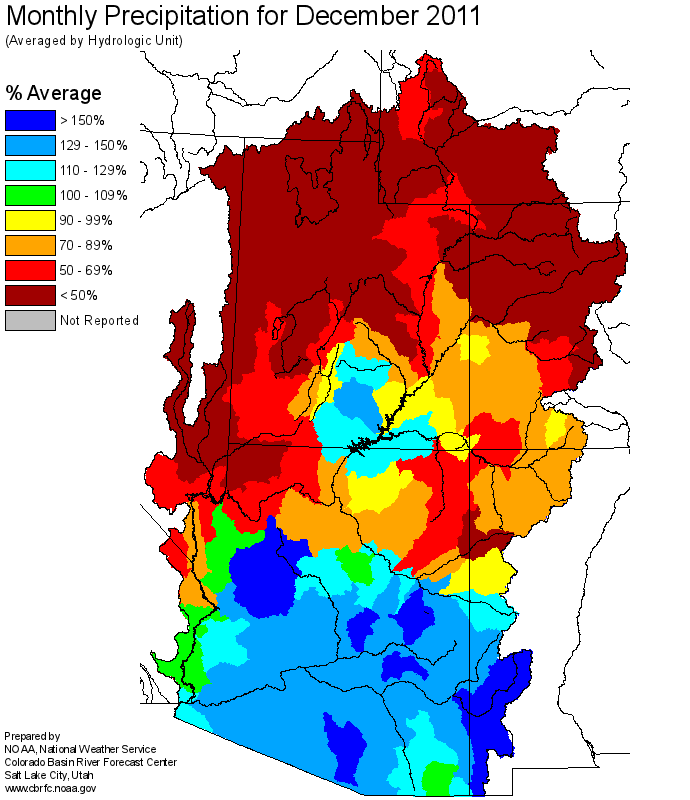New 1981-2010 Averages being used this year.
Note: This publication is currently undergoing major revisions. The current publication will be replaced with a new publication based on stakeholder requirements and scientific advances. We expect to begin sharing details on this soon. If you have input on content, format, or publication frequency at any time, please contact us at cbrfc.webmasters@noaa.gov.Lake Powell Water Supply Outlook, January 1, 2012Lake Powell Water Supply Outlook, January 1, 2012
Contents
Lake Powell Sub-Basin Summaries
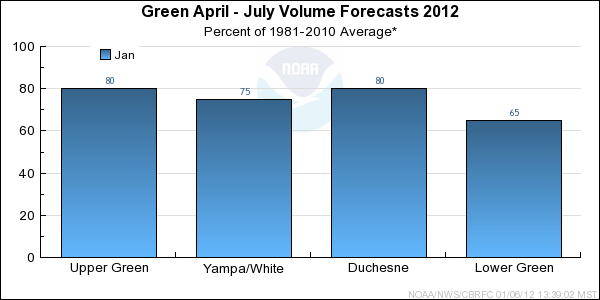
*Median of forecasts within each basin.
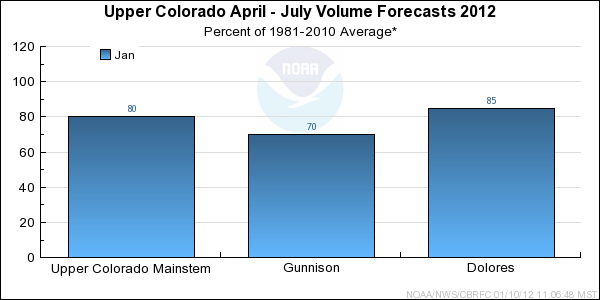
*Median of forecasts within each basin.

*Median of forecasts within each basin.
Upper Green Basin Conditions
The following conditions influenced this month's forecasts:
Precipitation:
Seasonal October through December
precipitation was 95 percent of average
in the Upper Green basin. December
precipitation was 50 percent of average.
Snow:
January 1st snow water equivalent was 75 percent of average in the basin.
--- Upper Green basin
snow
water equivalent plot.
Streamflow:
December streamflow was near 110 percent of average.
Soil Moisture:
Modeled
soil
moisture states indicated near average to above average soil moisture conditions
last fall prior to snow accumulation.
Climate Forecasts:
Climate forecasts were not a factor because there is not a strong correlation
between La Nina conditions and winter precipitation in the Upper Green basin.
Forecast Summary:
Seasonal precipitation in the Upper Green is near average as a result of much above average precipitation
in October and November. However, snow water equivalent is below average due to much below average
monthly precipitation in December. It is also important to note that fall soil moisture
conditions were near to above average. As a result, current April through July streamflow volume forecasts range
between 65 and 87 percent of average with a median value of 80 percent.
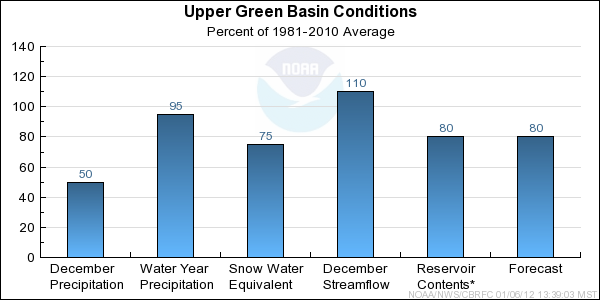
* Percent usable capacity, not percent average contents.
Click for multi-month Graph.
Yampa/White Basin Conditions
The following conditions influenced this month's forecasts:
Precipitation:
Seasonal October through December
precipitation was 70 percent of average
in the Yampa/White basin. December
precipitation was 30 percent of average.
Snow:
January 1st snow water equivalent was 65 percent of average in the basin.
--- Yampa basin
snow
water equivalent plot.
Streamflow:
December streamflow was near 120 percent of average.
Soil Moisture:
Modeled
soil
moisture states indicated above average to much above average soil moisture conditions
last fall prior to snow accumulation.
Climate Forecasts:
Climate forecasts were not a factor in the forecasts because there is not a strong correlation
between La Nina conditions and winter precipitation in the Yampa/White basin.
Forecast Summary:
Seasonal precipitation is below average and snow water equivalent is much below average in the Yampa/White basins
as a result of an extremely dry December. It is also important to note that fall soil moisture conditions
were above to much above average. As a result, current April through July streamflow volume forecasts range
between 68 and 83 percent of average with a median value of 75 percent.

* Percent usable capacity, not percent average contents.
Click for multi-month Graph.
Duchesne Basin Conditions
The following conditions influenced this month's forecasts:
Precipitation:
Seasonal October through December
precipitation was 90 percent of average
in the Duchesne basin. December
precipitation was 40 percent of average.
Snow:
January 1st snow water equivalent was 65 percent of average in the basin
as a whole.
--- Duchesne basin
snow
water equivalent plot.
Streamflow:
December streamflow was 120 percent of average.
Soil Moisture:
Modeled
soil
moisture states indicated much above average soil moisture conditions
last fall prior to snow accumulation.
Climate Forecasts:
Climate forecasts were not a factor in the forecasts because there is not a strong correlation
between La Nina conditions and winter precipitation in the Duchesne basin.
Forecast Summary:
Seasonal precipitation in the Duchesne is near average as a result of much above average precipitation
in October and near average precipitation in November. Snow water equivalent is much below average for the
majority of the basin due to much below average monthly precipitation in December. However, the snow water
equivalent for the eastern portion of the basin is near average resulting in somewhat
higher forecasts. It is also important to note that fall soil moisture conditions were
much above average. As a result, current April through July streamflow volume forecasts range between 63 and 104
percent of average with a median value of 80 percent.

* Percent usable capacity, not percent average contents.
Click for multi-month Graph.
Lower Green Basin Conditions
The following conditions influenced this month's forecasts:
Precipitation:
Seasonal October through December
precipitation was 80 percent of average
in the Lower Green basin. December
precipitation was 40 percent of average.
Snow:
January 1st snow water equivalent was 40 percent of average in the basin
as a whole.
--- Lower Green basin
snow
water equivalent plot.
Streamflow:
December streamflow was near 130 percent of average.
Soil Moisture:
Modeled
soil
moisture states indicated near average to above average soil moisture conditions
last fall prior to snow accumulation.
Climate Forecasts:
Climate forecasts were not a factor in the forecasts because there is not a strong correlation
between La Nina conditions and winter precipitation in the Lower Green basin.
Forecast Summary:
Seasonal precipitation is below average and snow water equivalent is much below average in the Lower Green due to
below average monthly precipitation in November and December. It is also important to note the fall soil moisture
conditions were near to above average. As a result, current April through July streamflow
volume forecasts range between 60 and 75 percent of average with a median value of 65 percent.
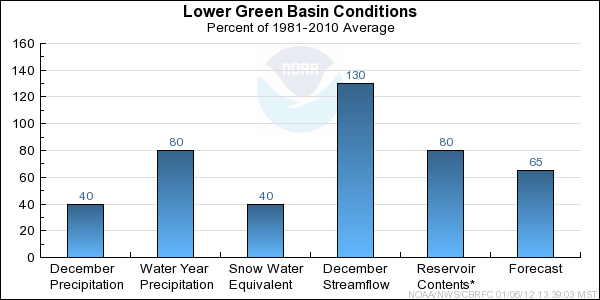
* Percent usable capacity, not percent average contents.
Click for multi-month Graph.
Upper Colorado Mainstem Basin Conditions
The following conditions influenced this month's forecasts:
Precipitation:
Seasonal October through December
precipitation
was near 70 percent of average in the Upper Colorado mainstem basin.
The new water year started well with above average precipitation in October;
however, November precipitation was below average and then December
precipitation was just 35 percent of average.
Snow:
January 1st snow water equivalent was near 60 percent of average in the basin as a whole.
--- Upper Colorado basin
snow
water equivalent plot
Streamflow:
December streamflow was near 110 percent of average.
Soil Moisture:
Modeled
soil
moisture states were above average heading into the winter.
Climate Forecasts:
La Nina climate conditions exist but these do not show a strong correlation with winter
precipitation in the Upper Colorado mainstem basin, and therefore were not influential in the development
of streamflow volume forecasts.
Forecast Summary:
Because of the below average November and, especially, December precipitation, as of January 1 both the
seasonal precipitation and snow water equivalent are much below average at 70% and 60%, respectively.
However, due to a very good runoff season last year and a wet October, above average soil moisture conditions
existed in the Upper Colorado mainstem heading into the winter season.
Therefore, current April through July streamflow volume
forecasts
range between 72 and 86 percent of average with a median value of 80 percent.
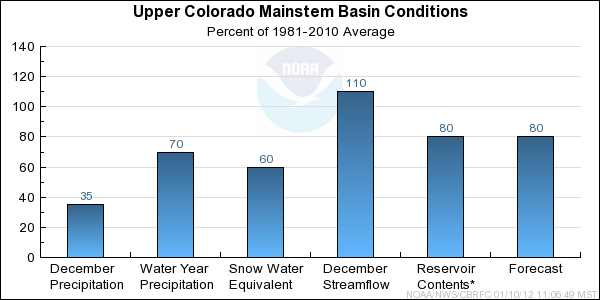
* Percent usable capacity, not percent average contents.
Click for multi-month Graph.
Gunnison Basin Conditions
The following conditions influenced this month's forecasts:
Precipitation:
Seasonal October through December
precipitation was 75 percent of
average in the Gunnison Basin. Above average precipitation occured in October. Dry
conditions and much below average precipitation occurred in November.
December
precipitation was also much below average, ranging from
30 percent of average in the East River watershed to 70% of average in the Uncompaghre
watershed. The Gunnison basin-wide average for December was 50%.
Snow:
January 1st snow water equivalent was 65 percent of average in the Gunnison basin.
Gunnison Basin
snow
water equivalent plot
Streamflow:
December streamflow volumes ranged from 85 to 90 percent of average.
Soil Moisture:
Modeled
soil
moisture states were above average entering the winter season.
Climate Forecasts:
La Nina climate conditions exist but these do not show a strong correlation with winter
precipitation in the Gunnison Basin, and therefore were not influential in the development
of streamflow volume forecasts.
Forecast Summary:
A wet October was followed by drier condtions in November and December. Seasonal precipitation was
near 75 percent of average as of January 1st, with a basin snow water equivalent value near 65 percent
of average. High runoff in 2011 and a wet October resulted in above average soil moisture in the
Gunnison Basin entering the winter season, impacting the forecasts. April-July
streamflow runoff volumes are expected to range between 60 and 80 percent of the 1981-2010 average
as of January 1st.
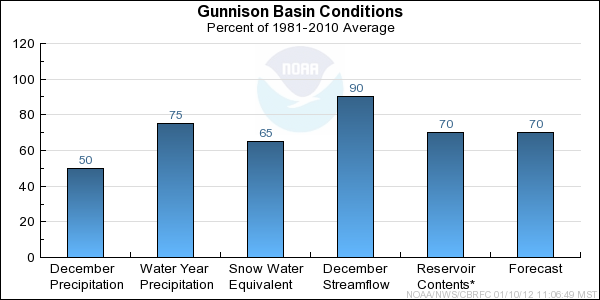
* Percent usable capacity, not percent average contents.
Click for multi-month Graph.
Dolores Basin Conditions
The following conditions influenced this month's forecasts:
Precipitation:
Seasonal October through December
precipitation was 90 percent of average.
Precipitation was above average in October and much below average in November.
December
precipitation was near 90% of average.
Snow:
January 1st snow water equivalent was 85 percent of average in the Dolores Basin.
Dolores Basin
snow
water equivalent plot
Streamflow:
Many streamflow gages do not function well during the winter. December streamflow volumes in
the Dolores River Basin have been estimated near 60% of average.
Soil Moisture:
Modeled
soil
moisture states were near to above average entering the winter season.
Climate Forecasts:
La Nina climate conditions exist but does not show a strong correlation with winter
precipitation in the Dolores Basin. Therefore, it was not influential in the development
of streamflow volume forecasts.
Forecast Summary:
Near to above average soil moisture existed in the Dolores River Basin entering the winter
season. Above average precipitation occurred in October. Precipitation was much below
average in November and near to below average in December. Seasonal precipitation was 90
percent of average on January 1st with snow water equivalent near 85 percent of average.
April-July
streamflow runoff volumes are expected to range from 70 to 80
percent of the 1981-2010 average.
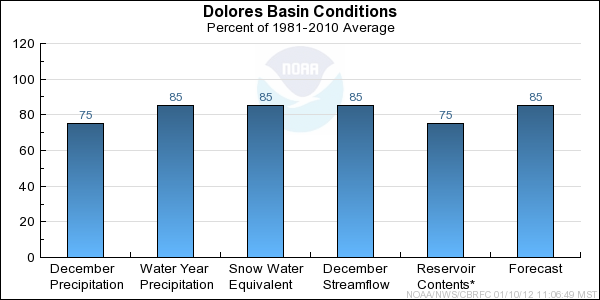
* Percent usable capacity, not percent average contents.
Click for multi-month Graph.
San Juan Basin Conditions
The following conditions influenced this month's forecasts:
Precipitation:
Seasonal October through December
precipitation is above average due to a wet
October. November was dry with
precipitation amounts generally less than 70 percent of average.
December
precipitation was generally below average across much of the Basin, with the exception of a few high
elevation sites that received amounts near or slightly above average.
Snow:
Current snow water equivalent for the entire basin is 85% of average for early January. The Animas basin was near 90% of average
on January 1st and the San Juan above Navajo was near 80 percent of average.
Animas River Basin
Snow Plot.
San Juan Basin (above Navajo Reservoir)
Snow Plot.
Streamflow:
Streamflow volumes for December ranged from 65% of average at the Basin outlet to near 90% of average at higher elevations.
Soil Moisture:
Modeled soil moisture indicated near to slightly above average soil moisture conditions over the San Juan Basin last fall,
prior to the onset of snow accumulation.
Climate Forecasts:
La Nina climate conditions exist and a weak to moderate La Nina episode is anticipated to continue through the winter
season. The La Nina climate condition suggests drier than average conditions possible over the San Juan Basin. The
La Nina climate condtion was considered when developing the forecasts.
Forecast Summary:
Seasonal precipitation is above average due to a wet October. Snowpack conditions are below average due to drier
weather in November and December. Soil Moisture was near to slightly above average entering the winter
season. La Nina climate conditions suggest below average precipitation is possible over the San
Juan Basin through spring. April-July
runoff volumes are expected to range from 75 to 95 percent
of the 1981-2010 average.

* Percent usable capacity, not percent average contents.
Click for multi-month Graph.
Differences between the full period forecasts and the residual forecasts may not exactly equal the actual observed volumes due to rounding conventions (see Definitions section).
Reservoir Monthly Inflow Forecasts
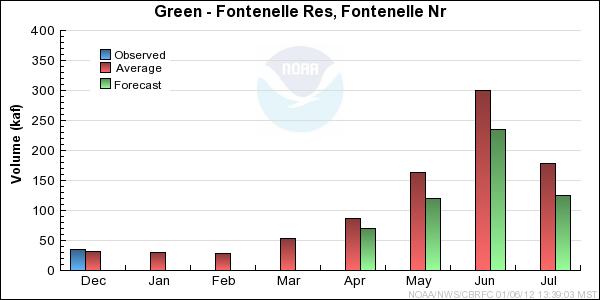
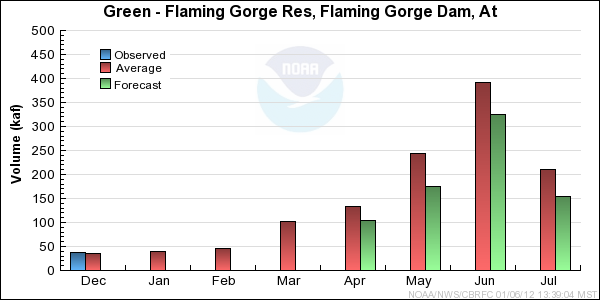
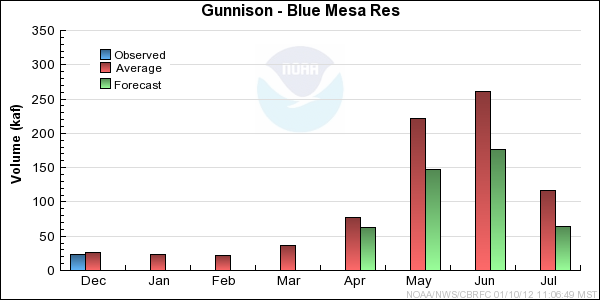
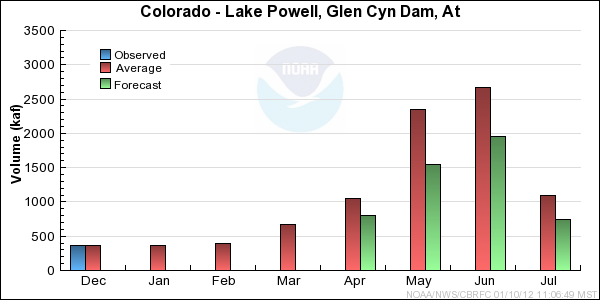

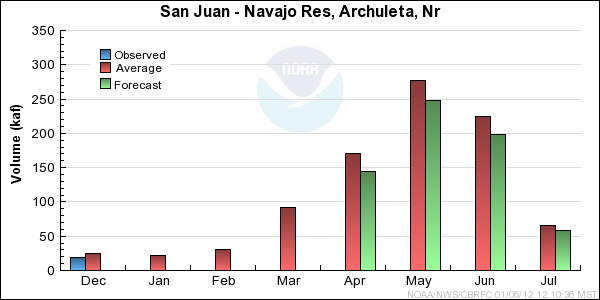
Monthly Streamflows
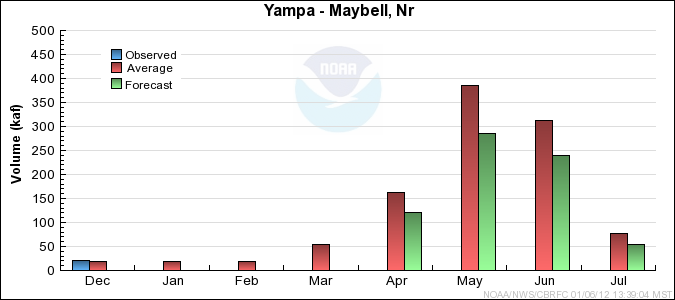
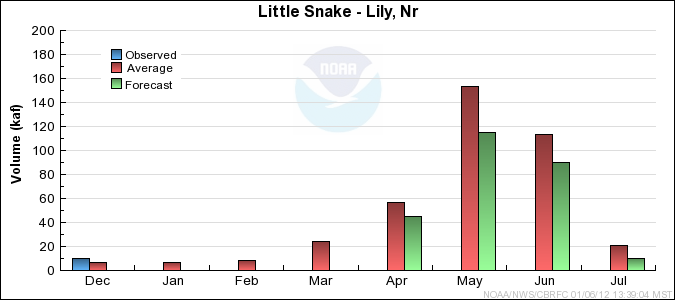
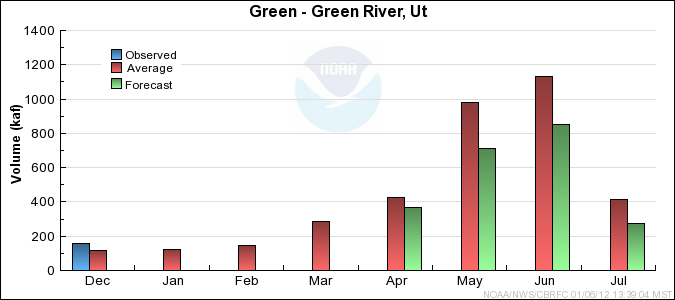
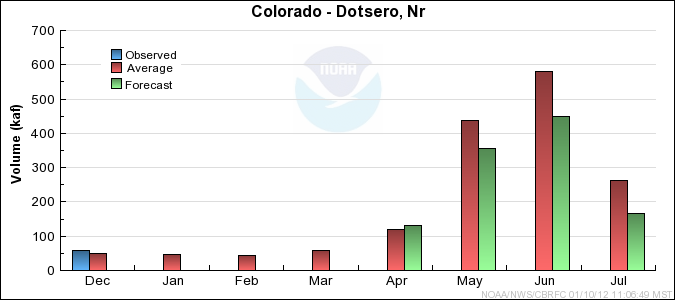
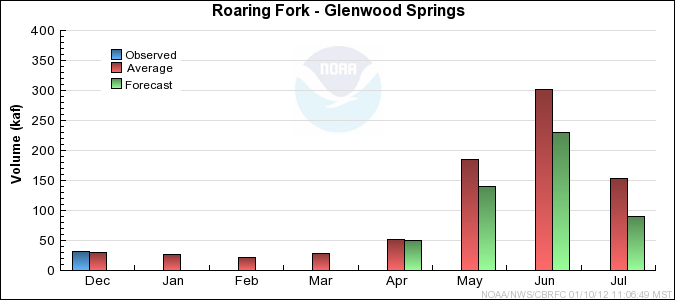
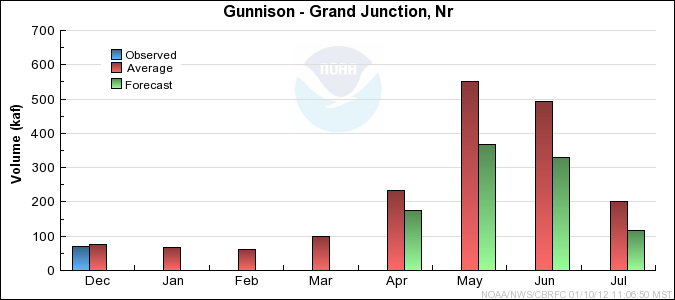
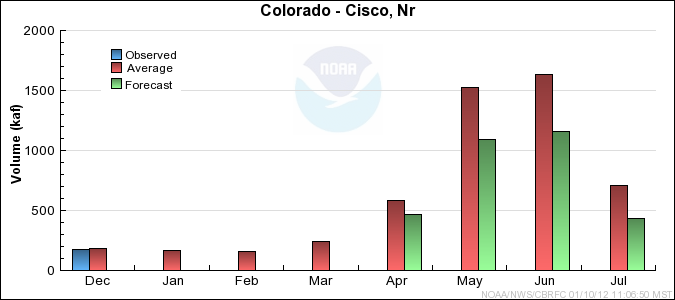
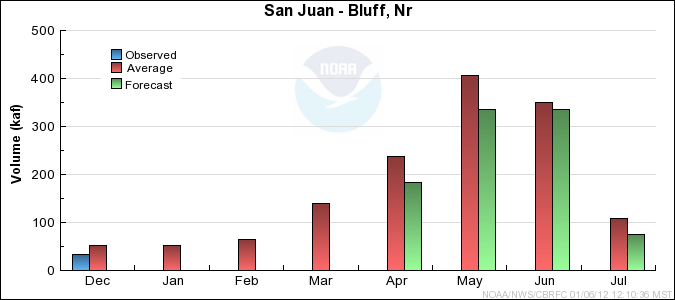
Precipitation Maps
